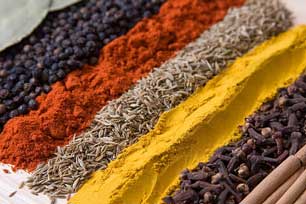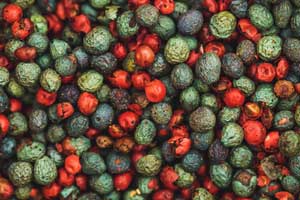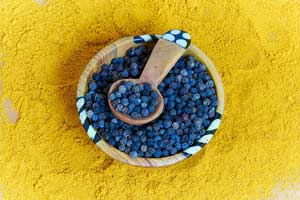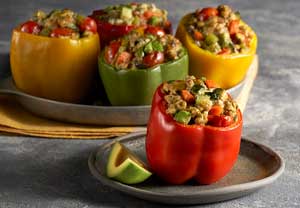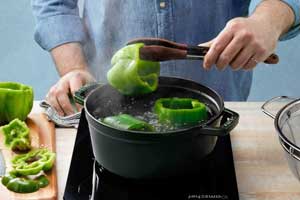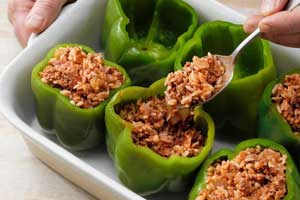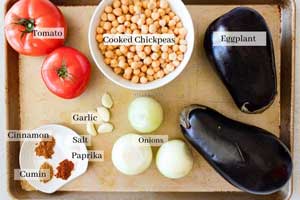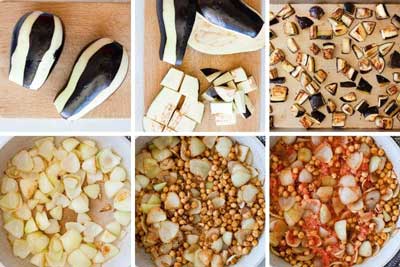If you’ve ever yearned for a dip that is luxurious, smoky, and explosively flavorful, then Mohammara is about to steal your heart. Originating from the Levant, particularly the Syrian city of Aleppo, this vibrant red dip combines roasted bell peppers, toasted walnuts, and a gentle heat from Aleppo chili to create a culinary masterpiece. Whether served as an appetizer, a spread for warm bread, or a condiment alongside grilled meats, Mohammara is a culinary revelation that elevates any meal. Today, we’ll explore a recipe that turns simple ingredients into a gourmet experience, celebrating the sweet and smoky allure of bell peppers.
Ingredients You’ll Need
For this recipe, we’re blending a handful of Mediterranean treasures into a dip that balances sweetness, spice, and richness. Here’s what you’ll need:
- 3 large red bell peppers – roasted until their skins blister and char for a smoky depth
- 1 cup walnuts – lightly toasted to unlock their nutty aroma
- 1/4 cup breadcrumbs – preferably from crusty artisan bread for texture
- 2–3 tablespoons pomegranate molasses – the secret to that tangy-sweet punch
- 1–2 cloves garlic – finely minced or roasted for mellow warmth
- 1 teaspoon Aleppo chili flakes – optional, but essential for authentic warmth
- 1/2 teaspoon smoked paprika – enhances the smoky undertones
- 1/4 teaspoon ground cumin – earthy and grounding
- 3 tablespoons extra virgin olive oil – rich, fruity, and golden
- Salt to taste – the enhancer of flavors
- Juice of half a lemon – for a bright, citrusy finish
- Optional garnish: pomegranate seeds, extra walnuts, drizzle of olive oil
Power tip: For a smoother, creamier Mohammara, you can soak the walnuts in warm water for 10 minutes before blending.
Step 1: Roast the Bell Peppers
Roasting bell peppers is the heart of this recipe—it’s where the magic begins. The skins blister, the flesh softens, and the natural sugars caramelize, creating that deep, seductive flavor that makes Mohammara irresistible.
- Preheat your oven to 220°C (425°F).
- Place the bell peppers on a baking sheet lined with parchment paper. Roast for 25–30 minutes, turning occasionally, until the skins are charred and wrinkled.
- Once roasted, place the peppers in a bowl and cover with plastic wrap for 10 minutes. This steaming process loosens the skins, making peeling effortless.
- Peel off the skins, remove seeds, and roughly chop the flesh.
Pro tip: Don’t rinse the peppers—keep the juices for extra flavor.
Step 2: Toast the Walnuts
Walnuts bring a luxurious richness and subtle crunch to Mohammara. Toasting them releases oils and deepens their flavor.
- Heat a dry skillet over medium heat.
- Add walnuts and toast for 5–7 minutes, shaking frequently to prevent burning.
- Let them cool slightly before blending.
Flavor hack: A light pinch of salt while toasting can enhance the nutty aroma.
Step 3: Blend the Magic
Now comes the fun part—transforming humble ingredients into a gourmet dip.
- In a food processor, combine the roasted bell peppers, toasted walnuts, breadcrumbs, garlic, Aleppo chili flakes, smoked paprika, and ground cumin.
- Pulse until the mixture begins to form a coarse paste.
- Slowly add pomegranate molasses, lemon juice, and olive oil, blending until smooth. Adjust the seasoning with salt and more chili if desired.
Texture tip: For a chunkier, rustic Mohammara, pulse less frequently. For a silky, spreadable dip, blend longer.
Step 4: Taste and Adjust
This is where your taste buds take center stage. Mohammara should hit all the right notes: sweet, smoky, nutty, and slightly tangy with a gentle fiery kick.
- If it’s too thick, add a teaspoon of water or extra olive oil.
- If it’s too tangy, a drizzle more of pomegranate molasses will balance it.
- For extra depth, a dash of smoked paprika or even a touch of chili oil can intensify the flavor.
Step 5: Serve and Garnish
Presentation is everything. Serve Mohammara in a shallow bowl, and let its vibrant red hue shine. Drizzle a bit of olive oil on top, sprinkle with chopped walnuts, and scatter a few pomegranate seeds for a burst of color and freshness.
Serving ideas:
- Spread on warm pita or flatbreads
- Pair with grilled lamb, chicken, or fish
- Serve as part of a meze platter with hummus, baba ganoush, and tabbouleh
- Use as a sandwich spread or toast topper
Pro tip: Mohammara tastes even better after a few hours in the fridge—flavors meld and intensify, creating a bold, irresistible dip.
Why This Dip is Legendary
Mohammara is more than just a dip—it’s a culinary journey. Every bite captures the smoky warmth of roasted bell peppers, the earthy richness of walnuts, and the tangy sweetness of pomegranate molasses. This dish embodies the spirit of the Levant, where spices, nuts, and fresh produce collide to create extraordinary flavors.
Unlike everyday condiments, Mohammara carries history, culture, and story in every spoonful. It’s bold, fiery, and luxurious—all at once.
Tips for the Perfect Bell Pepper Mohammara
- Choose ripe red bell peppers for natural sweetness and depth.
- Roast, don’t boil—the smoky char transforms the flavor.
- Use freshly toasted walnuts—stale nuts can make the dip bitter.
- Pomegranate molasses is key—it’s the secret ingredient that gives Mohammara its signature tang.
- Adjust the heat—Aleppo chili flakes provide warmth without overwhelming the sweet and nutty flavors.
- Make ahead—Mohammara improves after a day in the fridge, making it ideal for entertaining.
Storage and Shelf Life
Store Mohammara in an airtight container in the refrigerator for up to 5–7 days. The flavors continue to intensify over time, so it’s perfect for meal prep or for making ahead for a dinner party. For longer storage, you can freeze Mohammara in small portions—thaw and stir before serving.
A Celebration of Flavor
Every spoonful of this red, velvety dip tells a story—from the sun-drenched fields of Aleppo to your kitchen table. Mohammara is proof that simple ingredients can create extraordinary experiences, and that bell peppers, walnuts, and spices are more than just food—they’re history, culture, and passion, all blended into one unforgettable bite.
Try it today: spread it on bread, dollop it alongside grilled meats, or enjoy it straight from the bowl. Mohammara is bold, beautiful, and unapologetically flavorful—a dip that transforms every meal into a Mediterranean celebration.
